|
At
the August Logan County Genealogical and Historical Society meeting,
Rick Klinedinst gave a presentation on the history and activities at
Camp Ellis, which was open during World War II.
Klinedinst is a Lincoln enthusiast, so he said he has done many
programs about Abraham Lincoln. Recently, he has been asked to do
programs about Camp Ellis.
When Klinedinst was growing up, he spent a lot of time in the Ipava
area, where Camp Ellis had been located. He would ride his
motorcycle to see his girlfriend [now his wife] that lived about two
miles from where the camp was.
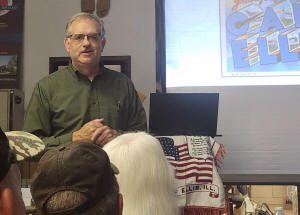
During World War II, Klinedinst
said there was a need for training facilities. He said Camp Ellis
was “originally called the Lewiston Project [and then] it changed
its name to Spoon River and finally to Camp Ellis shortly before
opening.”
The camp got its name from “Sergeant Michael R. Ellis, a World War I
hero, who captured sixty Germans and knocked out twelve machine gun
nests on the first day of the offensive in France.”
Initially, the camp was going to be a training area for foot
soldiers. When Camp Ellis was built it became a training center for
services of supply. Klinedinst said “the Camp was designed to train
men in army supply and support forces, not combat or foot soldiers.”
The location was chosen because it had access to railroads, it was
relatively open and cheap land and it was flat land, so it was not
going to take much to demolish it.
The site was near fresh water and Klinedinst said it was not close
to distractions. They did not want a camp near major cities, which
would be too much of a distraction for the servicemen.
Klinedinst said, “construction of Camp Ellis began on September 17,
1942. It consumed 17,800 acres and 125 farms. They later added 1,800
acres for an airport for a total of 19,600 acres.”

There were originally about 1100
people who lived in what Klinedinst called a triangle between Ipava,
Bernadotte and Table Grove, but within a few short months, the
population grew to 50,000. He said, “Camp Ellis became a small city
within eight short months.”
These towns did not have a lot of services, but Klinedinst said the
construction people needed a place to live and restaurants were
“bursting at the seams.”
When the government drew up plans, Klinedinst said they “surveyed
over 17,800 acres of farmland which was purchased. A lot of the
farmers and their families were displaced within thirty days.” Many
families owned these farms since the 1800s.
Camp Ellis swallowed up 125 farms. The government condemned these
farms and took the land by “eminent domain,” and Klinedinst said
they paid up to 60 percent or less of the value of these farms. He
said they were not very kind to the farmers as they told them to get
out. Many had already planted crops in their fields.
The winter of 1942 had weather that “did not cooperate.” Klinedinst
said there was a lot of rain, it was cold and it was hot. For a
while, people called it Camp Ellis and said, “you could stand in mud
up to your knees with dirt blowing in your face.” The Illinois River
had flooded in many places.
In 1942, construction workers began building Camp Ellis. Klinedinst
said, “from September 1942 to mid-April 1943, more than 2,200
buildings were erected.” Jobs in the construction trades and other
trades were plentiful. Towns around the Camp exploded overnight and
it was good for their economy.
The types of buildings that were mostly wood were finished with
fireproof sheetrock or gypsum, so Klinedinst said they were cheaply
made for the most part. The buildings included “eighteen Camp
exchanges or stores [that] were conveniently placed in the barracks
area.”
The barracks housed 50 men, but Klinedinst said they had no running
water in them and used the stove for heat.
The camp also had “six auditoriums, nine chapels, two libraries, two
service clubs, and two guest houses.”
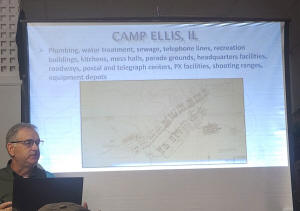
In addition, Klinedinst said “Camp
Ellis had plumbing, water treatment, sewage, telephone lines,
recreation buildings, kitchens, mess halls, parade grounds,
headquarters facilities, roadways, postal and telegraph centers, PX
facilities, shooting ranges, equipment depots and its own fire
station.” As he said, it was “everything needed for an army
community.”
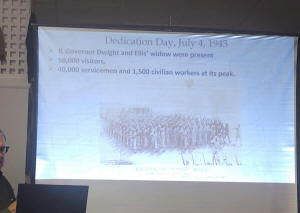
In April 1943, Camp Ellis opened
and “was dedicated on July 4, 1943, with Illinois Governor Dwight
and an estimated 50,000 visitors in attendance.” One person
Klinedinst said was at the dedication was Michael Ellis’ widow.
With 50,000 visitors, plus the
people who were already at Camp Ellis, there were around 90,000
people. Klinedinst said the roadway to Camp Ellis was backed up to
the Havana bridge close to 20 miles away.
According to Klinedinst, “at its peak, Camp Ellis numbers reached
over 40,000 servicemen stationed there and 1,500 civilian workers,
men and women” [and] this didn't include the POWs.” He said, “when
functioning fully, Camp Ellis may have been second only to Chicago
as an Illinois population center.”
In total, Klinedinst said Camp Ellis trained “over 300,000 men in
quartermaster corps, medical corps, signal corps, engineer corps,
ordinance, transportation and special service troops.”

The camp had a very large hospital.
In fact, Klinedinst said,” the Station Hospital at Camp Ellis was
one of the largest World War Il Army hospitals in the country since
it occupied over 140 acres. One of its corridors was a staggering
2,939 feet long.” There were 1400 beds, with 125 for POWS.
At this hospital there were “nearly 500 nurses attended to the sick
and wounded in three shifts.” The hospital had all the modern
technology like x-ray machines, surgical and diagnostic machines and
that type of equipment. Klinedinst said the first brain operation
was done at the Camp Ellis hospital by a surgeon flown in from
California.
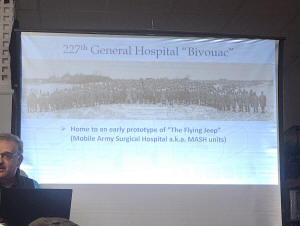
It had one of the first mobile
hospitals. Klinedinst said “Camp Ellis was home to an early
prototype what at first was nicknamed the “flying jeep,” [the 227th
General Hospital “Bivouac,”] but was known as a Mobile Army Surgical
Hospital, or MASH.”
The MASH unit was pretty much invented at Camp Ellis. Klinedinst
said it had everything necessary for a hospital—the equipment,
tents, medical supply, surgical tools, power generators and a jeep
outfitted as an ambulance.
Personnel would load three or four C-47 airplanes with the
equipment, land and then set up a MASH unit. Klinedinst said they
would have it set up for two or three days, then pack up and move to
the next area.
For the runway, Klinedinst said a steel girder was laid over the
land. The runway was 150 feet wide and 58 feet long. It took 1000
troops 24 hours to build the temporary airports using steel girders.
They would bring medical personnel in that way.
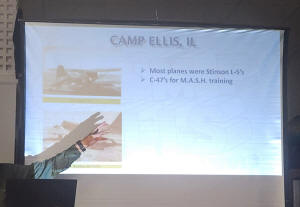
Most of the planes taking off from Camp Ellis were Stinson L5s,
which were small planes.
Almost every type of medical unit was trained at Camp Ellis.
Klinedinst said the 313th General Hospital had schools for cooks,
bakers, truck drivers, medical personnel, surgeons, x-ray
technicians, dental assistants and pharmacy technicians.
The bakers made over 500 loaves of bread each day when they were
overseas fighting. Klinedinst said they would use a hillside to set
up an oven.
Bernadotte, which Klinedinst said was known as the city of seven
hills, was completely taken over by the government. They made the
people vacate their homes and properties because it was needed for
the water supply, so a dam was built there.
The second reason Klinedinst said they used Bernadotte was for
training engineers to build bridges. What they would do is build a
bridge across Spoon River, then tear it down and rebuild it over and
over again. They built suspension bridges, pontoon bridges and steel
girder bridges strong enough for tanks to go over.
These bridges were usually built
within 72 hours. Klinedinst said nearly 300 bridges were built
across Spoon River.
Camp Ellis “maintained several large gyms where the troops formed
teams for basketball, boxing, physical weight training, and other
indoor sports.” Klinedinst said “the teams competed all over
Illinois and the Midwest.”
Additionally, “the soldiers played
tennis, bowling, volleyball, tackle and touch football, archery,
badminton, skating, and horseshoe pitching.”
At one time, Klinedinst said “the Camp had 184 softball teams in
organized leagues and 224 basketball teams.” As with the other
teams, basketball and softball teams “competed all over Illinois and
the midwest” against army teams and colleges.
[to top of second column] |

Throughout the whole camp,
Klinedinst said “gymnasiums, athletic houses, film theaters, concert
halls, libraries and places of worship were interspersed.
In the six theaters, Klinedinst said they showed first run Hollywood
movies to army men and civilians.
Boxers Joe Lewis and Sugar Ray Robinson drew a crowd of nearly
25,000 from the camp to their boxing exhibition. Other sports
figures who visited included White Sox pitcher Bill Fraizy and
Cleveland Indians pitcher Bob Feller. Klinedinst said movie stars
such as Red Skelton and Bob Hope came and entertained the troops.
During the years Camp Ellis was opened, USO clubs sometimes came to
the camp from nearby places such as Peoria, Pekin and Springfield.
Camp Ellis also “published its own newspaper called the Camp Ellis
News.” Klinedinst said the newspaper began “in April 1943 as a
small, four-page newspaper” and then “the newspaper increased to
over sixteen pages and had a circulation of over 13,700 at its
peak.”
Klinedinst said “the Camp had its own radio station which was the
only Army installation to have one. The station boasted an estimated
200,000 listeners per week. As it grew, six other radio stations
picked up Camp Ellis broadcasts and the catchword ‘Camp Ellis
Entertains’ became a listening habit every Tuesday evening.”
Camp Ellis even “had its own telephone company called Camp Spoon
River, through Illinois Bell, which included thirty-five switches
and over 1,000 lines.” Klinedinst said a three-minute call to
Chicago cost about 75 cents per minute.
The banking facility at the camp was run by Citizens National Bank
in Macomb.
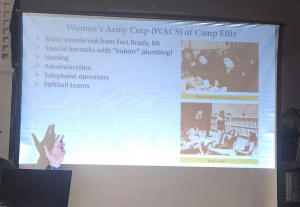
In 1944, women reported for duty at
the camp. Klinedinst said, “the first contingent of Women’s Army
Corp (WAC) arrived for duty at Camp Ellis on January 20, 1944. This
group consisted of 106 officers and enlisted personnel.” The women
served as nurses, administrators and telephone operators. He said
they even had their own softball teams.
When the women arrived, Klinedinst said the men at Camp Ellis were
very pleased. There were a lot of relationships formed, and many
weddings performed at the chapels.
Most of them transferred from Fort Brady in Michigan. The special
barracks built for the ladies had running water and indoor plumbing.
There was one part of the camp Klinedinst said people were tight
lipped about that was not in the original plans. This section had
high walls, barbed wire, towers and search lights. The speculation
was they were bringing in some kind of prisoners.
Many local residents did not want prisoners of war there, but by
1944, the first batch of POWs came to Camp Ellis. Klinedinst said,
the camp’s “first group of POWs, from North Africa and the European
theatre, totaling around 1,900, arrived at the camp shortly after it
was activated.” The Camp was considered a minimum-security prison
camp.
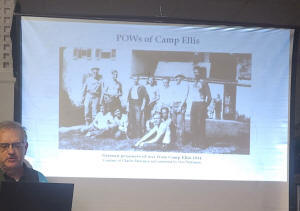
“At the highest point in 1944,”
Klinedinst said, “the prison housed almost 5,000 Germans, Austrian,
and Polish soldiers.” He said there were Nazis there who were
dedicated to the cause, but other Germans did not want anything to
do with the war, so there were sometimes fights with the walls.

The POWs did quite a bit of manual
labor at the camp such cutting brush, working in the fields, laying
brick, digging ditches, helping with the flooding in Pekin and
maintaining railroads. Klinedinst said the Nazis worked inside the
camp under constant guard, but Germans who were not Nazis worked
outside the camp unguarded. Some helped with building houses and
worked in the fields.
Camp Ellis sent 160 German prisoners to work at Mayo General
Hospital.
The prisoners received an allowance of ten cents a day and were paid
in chits, which looked like little coupons. The chits were for one,
five and ten cents. Klinedinst said it was against the Geneva
Convention for prisoners were not able to have any money.
At the end of the war, many of the German prisoners were reluctant
to leave. Many had a better life there than they had at home and did
not want to be shipped back to their own country.
Those who tried to escape were quickly brought back. Camp Ellis had
satellite camps at various places like Washington, Illinois.
Klinedinst said a prisoner named Reinhold Pabel escaped from
Libbie’s canning factory in Washington and eluded discovery for many
years. Pabel dyed his pants blue before escaping.
Pabel changed his name to Phil Brick and in 1953 the FBI finally
found him in Chicago. Brick had bought a bookstore and gotten
married, but he was sent back to Germany after being caught.
J. Edgar Hoover had written an article on “How Enemy Prisoners are
Captured.” Klinedinst said Brick was on trash duty and found a
magazine with the article. The article referred to “Operation Vapor”
and said, “do it alone, don’t talk more than necessary, get as far
away as soon as possible and have some cash to carry on you.” Hoover
said many people were captured because they did the exact opposite.
Among the POWs, Klinedinst said only four deaths occurred. Three
took place at the camp and one was at Percy Jones hospital. They
were all buried at Donnan Cemetery with military honors dictated by
the Geneva Convention. Later, the bodies were sent to Camp Sheridan.
Klinedinst said, “on October 1,1945, the entire Camp, land and
buildings costing a little over $23 million (nearly 400 million
today) was declared surplus by the War Department.”
The War Department then backed off and said the National Guard would
be there for a while, so they would not sell the land. Klinedinst
said, when the National Guard was done using it, the government was
then ready to sell the land back to the original owners.
Then, in 1953, the air force decided to use Camp Ellis as a survival
training area dropping troops into the camp for three or four days
to help them learn to survive in the wilderness.
Camp Ellis was one of three sites Klinedinst said was being
“considered to become the site of a new Air Force Academy; however,
they ended up choosing Colorado Springs, Colorado and they began its
construction in 1954.”
“In 1954, the Atomic Energy Commission announced plans to build a
$29,000,000 plant” to make explosive bombs, but Klinedinst said “a
year later they canceled those plans.”
Finally, Klinedinst said, “by the middle 1950s the land and
buildings had mostly been sold to civilian buyers in a series of
auctions.” They were sold by lots, churches, businesses and colleges
bought them. At Logan County Airport, one the barracks from the camp
serves as the Heritage In Flight Museum.
Some of the original owners did not
want the land back because they had relocated. Some were concerned
the government would come back and take their land again. Klinedinst
said prices were also 150 percent higher than many had originally
paid,
By spring 1955 all the land belonging to the camp was sold.
Klinedinst said 38 tracts of land were auctioned off and “the last
piece of Camp Ellis land was sold on April 26, 1955. The highest bid
was $360 per acre.”
Today though the camp is gone, Klinedinst said that the major’s
house and rifle ranges are still standing. A church in Peoria
Heights was moved from Camp Ellis.
To learn more about Camp Ellis, you can visit Easley Pioneer Museum,
home to a Camp Ellis exhibit, located in lpava, Illinois. Klinedinst
said the museum curators are Marion Cornelius and Julie Terstriep.
Several books have been written about Camp Ellis like one put out by
the army. One has letters from servicemen there and another is about
POWs who worked at the cannery in Washington. Most are out of
production and cost around $200.
Klinedinst wrote Camp Ellis, Once a City Not Forgotten, which tells
the story of Mary Haney who worked there from beginning to end. It
is out of production, but he hopes to get it updated.
After asking if any veterans were at the meeting, Klinedinst thanked
them for their service and everyone applauded.
When asked if there were any questions, Gary Dodson asked what
happened to the medical records of people there.
Unfortunately, Klinedinst said many records have been lost.
Diane Farmer, who had done a presentation on Camp Ellis for another
group told Klinedinst he did a great job. She said the only thing
she would add is that on Sunday, soldiers were invited into towns to
have Sunday dinners with families. The people in the towns were very
welcoming.

Klinedinst had several postcards,
news clippings and letters on display for everyone to view and gave
handouts with an outline of his presentation, a couple maps and some
news clippings.
Click here to read more Camp Ellis newspapers and view Julie
Terstriep’s Blog on Camp Ellis
here.
To learn more, please contact Rick Klinedinst at campellisil@aouok.com
At the next LCGHS meeting on Monday, September 16 at 6:30 p.m.,
Trevor Thompson, the new site service supervisor at New Salem will
give a presentation.
[Angela Reiners] |